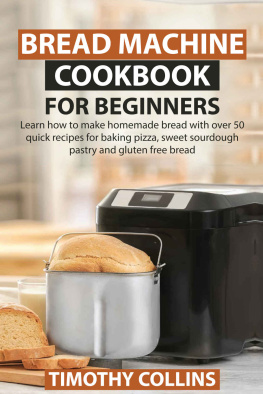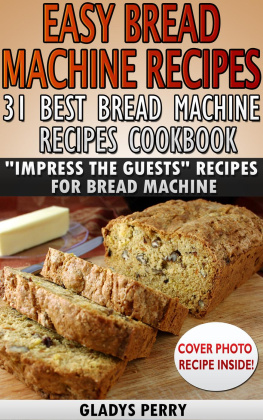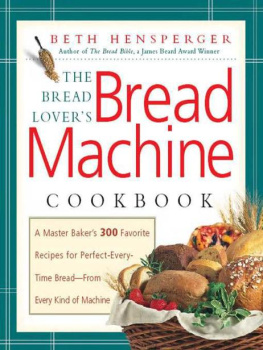 BREAD
BREAD
MACHINE
BAKING PERFECT EVERY TIME
75 FOOLPROOF RECIPES FOR
EVERY BREAD MACHINE ON THE MARKET
INCLUDING YOURS
Lora Brody and Millie Apter
 To all friendsespecially
To all friendsespecially
mothers and daughterswho
cook together
CONTENTS
Either you got it as a gift or you inherited it from someone who didnt use it, or you went out and bought it yourself. No matter how that bread machine made its way into your life, congratulate yourself and get ready for a treat. When bread machines first appeared ten years ago, they were bought by folks who didnt know a lot about baking bread but who craved the idea of waking up to the smell of a freshly baked loaf. Throw in the flour, water, yeast, press a button, and bingo! fresh bread is yours promised the manuals. This was true sometimes. For every perfect loaf, one had to deal with the hockey pucks, the spongy raw messes, the overflows, the inedible crusts, the sunken, fallen and otherwise disastrous products of the bread machine gone awry.
Some folks gave up, but most figured out that this machine is like any other kitchen tool: You have to make it work for you. The success rate increased when people stopped thinking the bread machine had a brain (although it does have a nifty computer chip) and started bossing it around a bit. I got my first bread machine as a lark: I love gadgets and, honestly, most get used and then stashed away. I quickly discovered, however, the enormous creative and nutritional potential of this marvelous machine. My bread maker never leaves the counter. I use it every single day to make bread for my family, pizza for a quick supper, scones for my husbands breakfast, or biscotti to bring as a gift.
Once youve gotten the hang of your bread machine, start looking in your grocery store, gourmet shop, and health food store for ingredients to go into it. The possibilities are vast and varied. Discover and use the dough cycle to make dough that you take out, form by hand, and bake in the oven. Any of the recipes in this book can be done this way. The rule of thumb is to allow the formed dough to rise on a baking sheet or in a bread pan until almost doubled in size, then to bake it at 375F for 40 to 50 minutes, or until the bottom sounds hollow when lightly tapped with your fingertips, or until a thermometer inserted into the bread reads an internal temperature of 190 to 200F. I hope you will redefine your idea of a failed loaf.
Just because it doesnt look like something you would find at your local bakery doesnt mean it wont taste good. When its sliced, who will know? If the bread doesnt rise at all, then remove the dough before the bake cycle goes on. Roll it out very thin and make flatbread or crackers. Not all breads rise to the top of the pan; the Swedish Rye (page 98), for example, is a very low, dense bread. Take care to read the description in the headnote before labeling that short, squat loaf a disaster. While testing recipes for this new edition and my other bread machine books, I got to know the machines (I own them all) inside and out.
Take the time to read all the information in this section of the book. Here you will find helpful hints, time-saving tips, and important information that will help you bake bread that is perfect every time.
Millie and I have always shared recipes, and bread machine recipes were no exception. She sent me hers from her Panasonic and I sent her mine from my DAK. Her recipes were my first failures and to my astonishment mine didnt work in her machine. There were other problems; the generic bread machine cookbooks gave one standard set of ingredients and instructions for large machines and another for small machines; many books required you to be able to read a recipe backward to fit the needs of your machine; all the recipes needed fine-tuning to really work.
What was going on here? Werent all those bread machines alike enough to use the same recipes? The answer was a big no. All bread machines are built on the same principle. A nonstick pan with a paddle on the bottom is snapped into a white metal box that becomes through the commands of a computer microchip a proofing box (to get the ingredients up to a temperature at which yeast begins to feed on the carbohydrates and sugars), a mixing and kneading machine, and finally an oven. These functions can be modified and adjusted somewhat by selecting a function on the pad on the front of the machine. Some machines come with a basic set of functions; and others come with a host of options. At first Millie and I assumed we could come up with a great recipe for, say, whole wheat bread and use it in any machine that called for three cups of flour. If that had been true, then writing this book would have been a piece of cake.
We quickly discovered that while the different brands of machines are subtly different from one another, it was enough to make it impossible to give a generic recipe that would be successful in every machine. To ensure success, we created a version of each recipe for each machine on the market. Nine hundred recipes later we present you with a book full of recipes that will work for you and your bread machine. We have tried, in this new edition, to include every machine on the market. If you dont find yours, or have bread machine questions, you can write me at P.O. Box 831, Newton Centre, MA 02159, or e-mail me at Blanche007@aol.com.
You wont find recipes for plain white bread in these pages. What you will find is a truly unique and innovative collection of breads made with a worldwide buffet of ingredients from goat cheese and sun-dried cherries to sweet marsala and pepper vodka. These one-of-a-kind recipes with their diverse and exciting ingredients will make stunning loaves that will please your taste buds and enrich your appreciation for bread as an art form. You can jump right in and make bread in your machine; but if you want guaranteed success every time, I suggest you read the information about flours and grains in this chapter. This step will make you as smart as your machine and help you develop your own recipes and be able to trouble-shoot with impunity should things run amok. At the end of many recipes weve offered variations and tips.
Dont forget to check for these notestheyll make your life easier and your bread more successful.
Small? Large? One-pound? One-and-a-half pound? Two-pound? Basic one-two-three model or multifunctional? Single loaf, double loaf with a rice and jam-making capability, window, wheat cyclethe choices are overwhelming! Should you go for the least expensive model or splurge on the most expensive? Buy it from a catalog, department store, cookware specialty shop, or discount chain? Okay, heres what we think: Small (1-pound) machine: If you are not terribly adventurous (i.e., wont be using the machine for anything beyond making bread) and you are baking for just one or two people, then consider one of the small (1-pound) machines. We have to warn you, though, many people start out with a small machine only to upgrade to a larger version once the bread-baking bug bites them. Large machine: Many of the machines in these pages make a loaf of bread that weighs in excess of two pounds. Confused? So were we until we figured out that when the manufacturers started talking about 2-pound loaves, they were talking volume, not weight. If you have a machine that calls for three to three and a half cups of flour, then that machine has the capacity to make a loaf of bread that weighs two pounds.
Next page






 BREAD
BREAD To all friendsespecially
To all friendsespecially